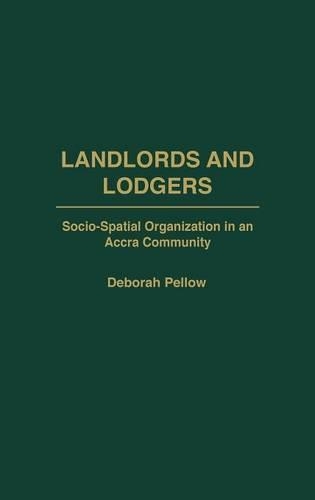
Landlords and Lodgers: Socio-Spatial Organization in an Accra Community
(Hardback)
Publishing Details
Landlords and Lodgers: Socio-Spatial Organization in an Accra Community
By (Author) Deborah Pellow
Bloomsbury Publishing PLC
Praeger Publishers Inc
30th August 2002
United States
Classifications
Tertiary Education
Non Fiction
Urban communities / city life
Regional / International studies
307.7609667
Physical Properties
Hardback
280
Description
An analysis of Accra, Ghana, that focuses on one neighborhood, showing how the social and spatial create everyday reality. Based on 25 years of research on and in Sabon Zongo, one of the oldest migrant communities in Accra, Ghana, this book is about the spatial and social production of this community within this urban setting. While Sabon Zongo is clearly part of the larger urban landscape of Accra, it is also culturally distinct, representing the melding of a migrant Hausa ethos, informed by Islam, its values and its institutions, and the metropolitan knowledge shared by all city dwellers. The author explores the interconnections of community residents to one another both in terms of built space--the boundaries of community, community structures, and compounds--and social space--the social networks, institutions, activities and routines through which Sabon Zongo residents reproduce meaning as constituted by and in their built environment. There is no body of data similar to this study's both in breadth and depth of understanding relating to this particular urban community. Much of the material has never been published. Both theoretically and substantively, this book makes a unique contribution to the literature on African urban life. Written in a clear, open style, this book will appeal to specialists and interested general readers alike.
Reviews
"Based on research carried out over two decades, this richly detailed study of Accra's Sabon Zongo (a Hausa word for "stranger quarter") neighborhood brings the geohistory of this urban enclave to life in ways that cultural-historical georgraphers will find both familiar and unique....This theoretically informed, well-researched, and closely written book should be quite useful in middle- and upper-level urban geography classes as a fine case study of urban sense of place in a unique, yet in some ways emblematic, West African neighborhood. The book's many photographs, maps, and illustrations, some of which originate in basic GIS analysis of the setting, add to the text's tapestry delineating place-meaning. In the end, one feels far less a stranger to the stranger quarter."-The Professional Geographer
Based on research carried out over two decades, this richly detailed study of Accra's Sabon Zongo (a Hausa word for "stranger quarter") neighborhood brings the geohistory of this urban enclave to life in ways that cultural-historical georgraphers will find both familiar and unique....This theoretically informed, well-researched, and closely written book should be quite useful in middle- and upper-level urban geography classes as a fine case study of urban sense of place in a unique, yet in some ways emblematic, West African neighborhood. The book's many photographs, maps, and illustrations, some of which originate in basic GIS analysis of the setting, add to the text's tapestry delineating place-meaning. In the end, one feels far less a stranger to the stranger quarter.-The Professional Geographer
[P]ellow's book will be useful as a basis for comparison for scholars who study Hausa communities in West African cities.-African Studies Review
"Pellow's book will be useful as a basis for comparison for scholars who study Hausa communities in West African cities."-African Studies Review
"[P]ellow's book will be useful as a basis for comparison for scholars who study Hausa communities in West African cities."-African Studies Review
Author Bio
DEBORAH PELLOW is Professor of Anthropology in the Maxwell School at Syracuse University.
